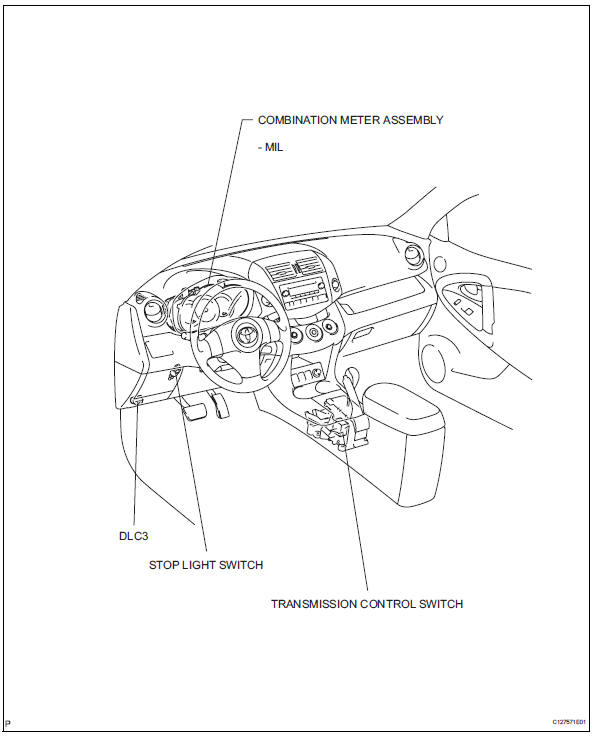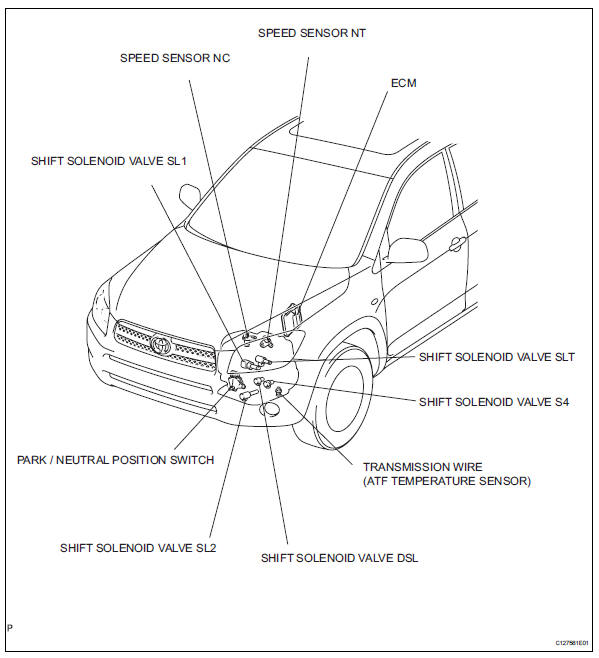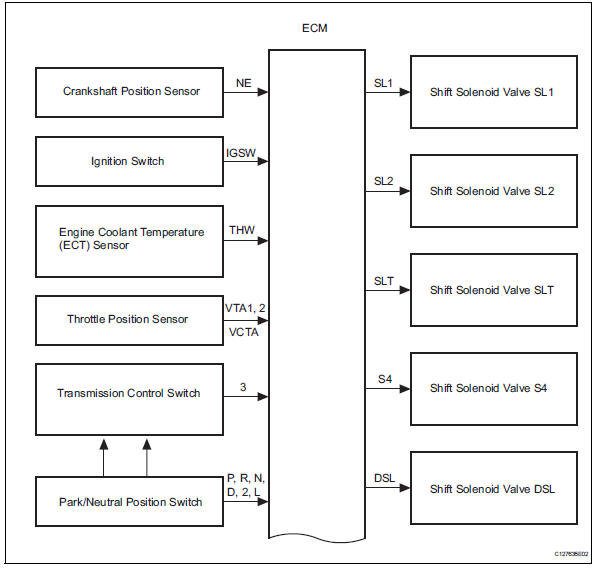Toyota RAV4 (XA40) 2013-2018 Service Manual: Parts location


System diagram
The configuration of the electronic control system in the u140f automatic transaxle is as shown in the following chart.




System description
- System description
- The electronic controlled automatic transaxle
(ect) is an automatic transaxle that electronically
controls shift timing using the engine control
module (ecm). The ecm detects electrical signals
that indicate engine and driving conditions, and
controls the shift point based on driver habits and
road conditions. As a result, fuel efficiency and
power transaxle performance are improved.
Shift shock is reduced by controlling the engine and transaxle simultaneously.
In addition, the ect has the following features:
- Diagnostic function.
- Fail-safe function when a malfunction occurs.
How to proceed with troubleshooting
Hint:
- The ecm of this system is connected to the can and multiplex communication system. Therefore, before starting troubleshooting, make sure to check that there is no trouble in the can and multiplex communication systems.
- *: Use the intelligent tester.
- Vehicle brought to workshop

- Customer problem analysis

- Inspect battery voltage
Standard voltage: 11 to 14 v
If the voltage is below 11 v, recharge or replace the battery before proceeding.

- Connect intelligent tester to dlc3*

- Check and clear dtcs and freeze frame data*

- Refer to the dtc check / clear (see page ax-29).
- Visual inspection

- Setting check mode diagnosis*
- Refer to the check mode procedure (see page ax-30).

- Problem symptom confirmation
- Refer to the road test (see page ax-12).
Result 


- Symptom simulation
- Refer to the electronic circuit inspection procedure (see page in-37).

- Dtc check*
- Refer to the dtc check / clear (see page ax-29).
Result 


- Basic inspection
- Refer to the automatic transmission fluid (see page ax-102).
- Refer to the park/neutral position switch (see page ax-108).
- Refer to the floor shift assembly (see page ax- 136).


- Mechanical system tests
- Refer to the mechanical system tests (see page ax-15).


- Hydraulic test
- Refer to the hydraulic test (see page ax-16).


- Manual shifting test
- Refer to the manual shifting test (see page ax- 17).


- Problem symptoms table chapter 1
- Refer to the problem symptoms table (see page ax-21).


- Problem symptoms table chapter 2
- Refer to the problem symptoms table (see page ax-21).

- Part inspection


- Dtc chart
- Refer to the diagnostic trouble code chart (see page ax-35).

- Circuit inspection

- Identification of problem

- Repair or replace

- Confirmation test

End
 Precaution
Precaution
Notice:
Perform the reset memory procedures (a/t
initialization) when replacing the automatic transaxle
assembly, engine assembly or ecm (see page ax-18).
Hint:
Reset memory cannot be completed b ...
 Road test
Road test
Problem symptom confirmation
Based on the result of the customer problem
analysis, try to reproduce the symptoms. If the
problem is that the transaxle does not shift up, shift
down, or ...
Other materials:
Rear seats
Adjustment procedure
Pull up the lever. Then lean back to the desired angle and release the
lever.
When a person sits in the rear center position, align all seatbacks at the
same angle.
Folding down the rear seatbacks
Before folding down the rear seatbacks
Stow the rear center seat bel ...
Installation
Hint:
Use the same procedures for the rh side and lh side.
The procedures listed below are for the lh side.
When installing the moulding, heat the vehicle body and
moulding using a heat light.
Standard heating temperature
Notice:
Do not heat the vehicle body and moulding
excessively ...
Fail-safe chart
If a problem occurs in the electric power steering system, the
p/s warning light will come on in the combination meter and
steering power assist will be stopped, fixed at a particular
point, or decreased simultaneously to protect the system.
Hint:
The amount of power assist may be decreased ...
